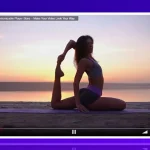Introduction
With over 36 million yoga practitioners in the United States alone, yoga is probably one of the top favorite activities for people from all around the world.
With live streaming becoming more readily available for yoga teachers and audiences continuously growing, it’s definitely worthwhile to take a look at how you can start offering either group, or one on one live yoga sessions on your very own website.
Yoga Streaming Best Practices
If you are a yoga teacher, you most likely already know most of your clients very well, but you won’t know your potential online audience. Hence, it’s worthwhile (You’re encouraged) to take some things into (thorough) consideration before starting your first live stream.
Niche Content
Before going forward, it’s also a good idea to take a look at your competition and what they are doing. Soon enough, you will start seeing a pattern – If you want your yoga channel to have success, you need to find a niche to work on.
You can, for example, combine yoga with other types of exercises or with weight loss. Developing a niche is very important at this stage – and it should be built around your target audience.
Courses Planning
Before starting a live stream, you should have a clear plan of the exercises and techniques you will go through for the day, since this will help everything run smooth. You can also give a short description of what you will do at the beginning of the stream.
Class & Audience
One thing you also need to keep in mind when streaming a yoga class is the fact that you can’t simply film your clients without their consent. Since you will be monetizing your videos, you will have to get your clients to sign a release form before starting the stream.
If that’s too much of a hassle, you can simply start off by only filming yourself, and none of your clients – a sort of online one on one yoga class just for your audience. This is a simpler method to stream and it can also be more rewarding and interactive for your viewers.
Advantages of Streaming a Yoga Class
- Pre-recorded videos are a thing of the past when it comes to teaching yoga since students cannot interact with the teacher and ask questions or get essential feedback.
- Since the yoga course is live streamed and can be accessed from just about any device with an internet connection, yoga students won’t have to commute or waste time by going to a yoga studio – they can exercise from the comfort of their own home.
- Not only that, but you will also have the freedom to stream your class whenever you wish. I.e: streaming from your living room instead of a costly yoga studio. Students who cannot attend your live streams due to various reasons will be happy to know that recordings of the class are available.
- Another great advantage of online yoga classes is the price most yoga teachers charge between $5 to $10 per class which is much more affordable than what the class would cost in a brick and mortar yoga studio.
Live Streaming Basics
If you are not already familiar with live streaming, don’t panic. It’s practically a household concept and you have probably done it before, but on free platforms such as Facebook or Twitter. The live streaming platform you will use needs to offer certain features such as:
- It has to be easy to use
- It has to be flexible
- It has to offer several monetization options – something that free platforms such as Facebook simply do not offer.
Disadvantages of Free Streaming Platforms
At first, you might be tempted to opt for a live streaming platform such as YouTube, which indeed, allows live streamed events. But take a closer look at the bullet points above. YouTube does not offer monetization options, except for meagre ad revenue.
YouTube may be the most popular platform for VODs and even live streaming, but you might want to have a little more privacy with your content – anyone with the link will be able to view your videos and even download them. This is an especially sensitive issue since you are streaming a yoga class which may involve some of your students as well.
Another popular free live streaming platform is of course Facebook. You will face the same issues here – monetization options are not available, there is no privacy for the content you broadcast and even worse – you will not be able to download recordings of your live streams, in case you want to sell them as pay-per-view videos.
Besides, your stream may also be subject to reports by Facebook users and get deleted. On the other hand, you can use Facebook as a means to promote your own website, where you make the rules.
Instagram is very similar to Facebook in terms of live streaming but with one major disadvantage. Apart from not offering monetization options, your recorded videos may also get deleted after a certain period of time. Accounts also get deleted, just as on Facebook due to various reasons – and you don’t want to be put in a position where you can lose all that work with no possibility of making any back-ups.
Disadvantages include
- They do not offer the possibility to monetize your content according to your niche or desires
- You do not have total control over your video files – where and how they are stored
- Privacy for yourself and your students can be an issue – anyone can view your content
- You cannot save your content and use it in other products; eg: turn your live streams into a bundle of courses and sell it as a standalone product
- Your content will be heavily moderated and tied to the rules of the live streaming platform; Youtube videos are often demonetized due to various reasons
- Ad revenue is one of the worst ways to monetize video content, due to meagre profit
Streaming with WpStream
WpStream offers content creators more freedom in just about any department – they can choose how to build their live stream page, who can actually see the stream and more importantly, how they want to monetize their content.
For example, you can offer live pay-per-view yoga sessions for your general audience and subscription-based sessions for a select few. The possibilities are endless, depending on your wants and needs.
WpStream works seamlessly with payment processing plugins such as WooCommerce and popular page builders such as WpBakery to deliver a solution that is easy to implement and easy to use even if you have no prior technical experience. We built WpStream with user friendliness in mind. To summarize, WpStream features & advantages include:
- Full WordPress stream theme available for free
- Two demo websites – Hollywood Demo & GoLive Demo
- Free streaming Plugin also available if you want to use another theme
- You have full control over your content
- Record, save and create products from the recordings of your streams
- Plenty of monetization options available
- Easy to learn & easy to use
- Customize your live streams with logos & other graphics by using a free, professional streaming app like OBS Studio
- Better privacy – all streams are encrypted
Streaming Equipment
Before starting your very own live yoga channel, you will need a couple of things, namely a WordPress website, a camera and a live streaming app.
Cameras
Live streaming cameras come in all shapes, sizes and price tags – the most accessible would have to be the smartphone, but other options are readily available, depending on the video quality you want to shoot for. The most common types of cameras used for streaming include:
Smartphones
- Webcams
- IP Cameras
- Professional Cameras
Streaming a Yoga Class with a Smartphone
Smartphones made their debut more than 10 years ago and quickly gained much popularity – these little devices are just about everywhere and we depend on them to access our bank account, check the weather and read news. Since smartphones feature excellent cameras and built in microphones, they are the perfect device for streaming.
Newer models offer excellent quality video which can be used for streaming but at the same time these little devices also come with a few disadvantages – namely the fact that the camera is built-in and sound quality is often poor. Light conditions can also affect a smartphone more than other types of streaming cameras, but a smartphone can be the perfect device to test and experiment with your first streaming channel.
Streaming a Yoga Class with a Webcam
Webcams are generally small cameras which use a USB to connect to a computer or laptop. They do not have their own internet connections, as smartphones do – this is why you will have to connect it to a laptop which will process any recorded video to a file which can be streamed over the internet.
Web cameras are somewhat of a better choice than smartphones, since they offer decent quality for a very reasonable price. A mid-level webcam can set you back around $70-80. Since the webcam will be fixed and you may need to move around your class, you will be required to buy if a separate microphone for better audio quality.
Streaming a Yoga Class with an IP Camera
IP cameras have one great advantage over webcams – they have the ability to connect to the internet through their own IP address. These types of cameras are mostly used for 24/7 live streams and can run just about anywhere – as long as they are connected to a power source and the internet. Setting up these cameras is a little bit more complicated than webcams for example. You should opt for an IP camera only if you want to stream continuously for multiple hours; eg: 4-5 hours daily.
Streaming a Yoga Class with a Professional Camera
Perhaps the best cameras for live broadcasting are HDMI or SDI professional cameras. These cameras generally offer excellent picture quality as well as a high degree of flexibility.
Filters are also helpful when using these cameras, as well as the ability to use an external monitor. One disadvantage of these cameras is the fact that they are generally a more complex than webcams, for example.
Other drawbacks can include the higher prices these cameras usually go for. A decent HDMI camera will set you back around $600 while other models can go for as much as $1200. HDMI professional cameras will also require a laptop or computer to process the recorded video into a format which can be streamed on your website.
You should only buy a professional camera if you are going to have a partner handling the camera for you.
Streaming Software
You will also need a computer able to run live streaming software. OBS Studio is currently one of the most popular free streaming apps. If you’re interested in streaming from mobile devices such as smartphones, you will need to pick a streaming app. Here’s a guide that can help you make the right choice, and a tutorial as well, available HERE.
After you get all of the hardware and software, you need to conduct tests to make sure they are running. You can also ask friends for tips and pointers on how to improve your stream quality.
Yoga Stream Monetization Options
As previously mentioned, the WpStream platform offers plenty of monetization options for your online yoga courses, the most popular of which being pay-per-view videos and subscription videos. Let’s take a look at the advantages and disadvantages of these options, and explain how they work for your online customers.
As the name suggests, these are free videos or recordings of your stream which you offer without an expectation of payment. We mentioned it in our article because free videos can prove to be a very powerful tool in your sales funnel; eg: transforming your website’s visitors into paying customers by sparking their interest with free materials.
Apart from that, even if the videos themselves are free, it does not mean that you can’t monetize them through advertising or even affiliate products.
Advantages
- Excellent marketing tool for your website
- They don’t require a lot of extra effort to create – you can just release some of your older premium videos
- Can be coupled with other paid products such as e-books
Disadvantages
- Very low returns for ads
- Free videos can consume a large chunk of your viewer hours
- It may be difficult to create niche content
- Very few users who watch free videos will turn into a paying customer
Pay-per-view videos can be a great way to monetize your online yoga course. As the name suggests, viewers will have to pay a one-time fee before they can have access to the video they want to watch.
This is the perfect solution for servicing casual yoga students or people who are relatively new to your content, since they don’t have to commit to a monthly fee. It’s important to note that most pay-per-view customers will come from your free videos.
Advantages
- You can set different prices for each individual video
- It’s a great way to have customers have a taste of your premium content
- Your customers don’t have to commit to your brand or content
Disadvantages
- Your viewers may watch one or two videos but abandon the brand afterwards
- Very few pay-per-view clients will turn into subscription clients
Subscription Videos
With a subscription business model, users will have to pay a monthly fee and they will have access to all of your website’s premium content. This monetization model is actually cheaper for the viewer than paying for each video individually.
This also means that the subscription model will only work for users who have a keen interest in your online content and live streams. The only disadvantage of this model is that users will be less inclined to commit to your content if they don’t know it well enough.
Advantages
- It’s cheaper in the long run for the viewer than buying each video separately
- Most subscribers will not cancel for at least 4-6 months
- You have a steady base income from your content
Disadvantages
- Viewers are less inclined to make long term commitments in general
- A small percentage of your viewer base will actually become long term subscribers
Hybrid Models
Just because we outlined the most popular monetization options for online businesses don’t think that you have to stick to only one model – the most effective monetization strategy is in fact a hybrid between all three models outlined above. All three models have advantages which you can leverage for the growth of your business.
Conclusion
As with any activity, it will take some time to get used to live streaming. No doubt, you will learn the basic concepts fairly quickly but it will take time to refine your product and engage your audience more effectively.
Table of Content







